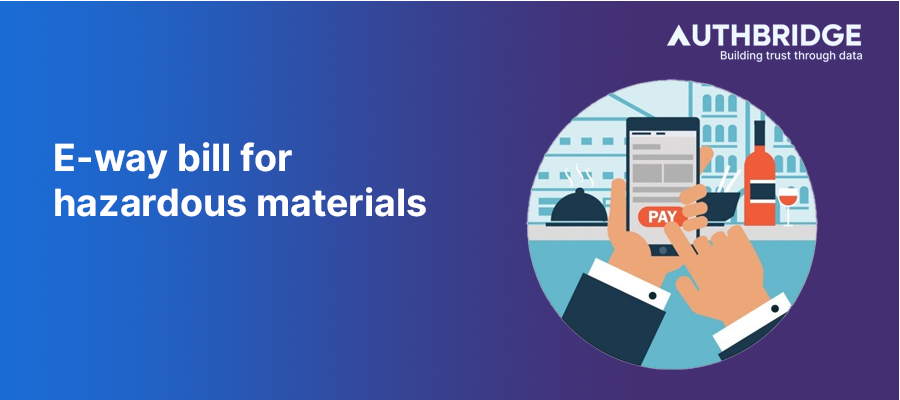A Comprehensive Guide

Understanding Hazardous Materials
Hazardous materials include a wide range of substances that pose risks to health, safety, property, or the environment during transportation. These can range from chemicals and toxic waste to flammable liquids and gases.
Overview of E-way Bill Necessities
For the transport of hazardous materials, E-way Bills serve as a critical tool for ensuring compliance with GST regulations, facilitating the tracking of goods, and ensuring that all necessary safety and regulatory information accompanies the transport of such materials.
Regulatory Framework for Hazardous Materials Transport
National and State Regulations
Transporting hazardous materials is governed by a combination of national regulations and state-specific guidelines, which outline the requirements for safe transport, including the generation of E-way Bills.
Specific E-way Bill Provisions for Hazardous Goods
Certain hazardous materials may have specific E-way Bill requirements, such as additional documentation or information fields that must be completed to comply with safety standards and regulatory mandates.
Generating E-way Bills for Hazardous Materials
Step-by-Step Compliance Process
- Identify the Material: Confirm that the material being transported is classified as hazardous.
- Gather Necessary Information: Collect all required information, including material classification, quantity, and emergency contact details.
- Generate E-way Bill: Use the official GST portal or approved software to generate the E-way Bill, ensuring all hazardous material-specific fields are accurately filled.
Special Documentation and Information Requirements
Transporting hazardous materials requires additional documentation, such as Material Safety Data Sheets (MSDS), emergency response plans, and permits, which should be reflected in or accompany the E-way Bill.
Challenges in E-way Bill Compliance for Hazardous Goods
Common Compliance Hurdles
Freight carriers and businesses face challenges such as accurately classifying hazardous materials, meeting all documentation requirements, and ensuring the timely generation of E-way Bills.
Mitigating Risks and Ensuring Safe Transport
Adopting comprehensive safety management systems, regular training for staff involved in the handling and transport of hazardous materials, and leveraging technology can help mitigate risks and ensure compliance.
Penalties and Legal Implications of Non-Compliance
Overview of Penalties
Failure to comply with E-way Bill requirements for hazardous materials can result in severe penalties, including fines, confiscation of goods, and legal action, depending on the severity of the violation.
Leveraging Technology for Compliance and Safety
The role of technology in managing E-way Bill compliance, especially for hazardous materials, cannot be overstated. Advanced software solutions offer features that not only streamline compliance processes but also enhance the safety and efficiency of hazardous material transport.
Key Features of Technology Solutions
Feature | Benefit |
Automated Classification | Helps in identifying and classifying hazardous materials accurately, ensuring compliance with specific E-way Bill requirements. |
Documentation Management | Stores and manages essential documents such as MSDS, permits, and emergency response plans, making them easily accessible during transport. |
Real-time Tracking | Enables businesses and authorities to track the movement of hazardous materials in real-time, enhancing safety and response capabilities in case of emergencies. |
Integration with Existing Systems
Integrating E-way Bill solutions with existing ERP or transport management systems can provide seamless data flow, reducing manual entry errors and ensuring that all necessary information is accurately reflected in the E-way Bill.
FAQs and Expert Insights on E-way Bill for Hazardous Materials (Continued)
Addressing Common Queries
- Q: How frequently do regulations regarding the transport of hazardous materials and E-way Bill requirements change?
- A: Regulations can change based on legislative updates or policy revisions. It's crucial for businesses to subscribe to updates from regulatory authorities and GST councils to stay informed.
- Q: Are there specific E-way Bill exemptions for certain types of hazardous materials?
- A: Yes, certain exemptions may apply based on the nature or quantity of hazardous materials. Businesses should consult the latest regulations or seek expert advice to understand specific exemptions.
Expert Tips for Smooth Compliance
- Continuous Monitoring: Implement systems for continuous monitoring of regulatory updates and integrate these changes into your compliance processes promptly.
- Safety Training: Invest in regular safety training for all employees involved in the handling and transport of hazardous materials, focusing on emergency response and E-way Bill compliance.
- Collaborative Approach: Foster a collaborative approach with regulatory authorities, transport partners, and clients to ensure a shared understanding of compliance and safety requirements.
Conclusion
Navigating the complexities of E-way Bill compliance for hazardous materials demands a comprehensive understanding of regulatory requirements, a proactive approach to safety, and the effective use of technology. By adopting best practices, leveraging advanced software solutions, and staying informed about regulatory changes, businesses and freight forwarders can ensure compliance, enhance safety, and facilitate the smooth transport of hazardous materials.
Category

Abhinandan Banerjee
(Associate Manager - Marketing)
Abhinandan is a dynamic Product and Content Marketer, boasting over seven years of experience in crafting impactful marketing strategies across diverse environments. Known for his strategic insights, he propels digital growth and boosts brand visibility by transforming complex ideas into compelling content that inspires action.



